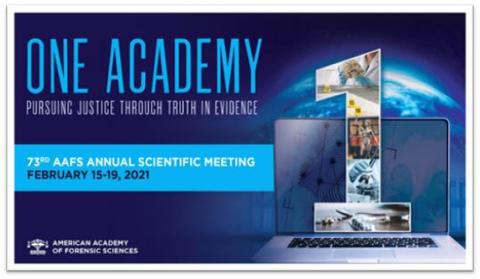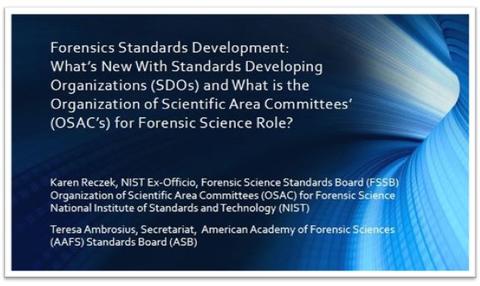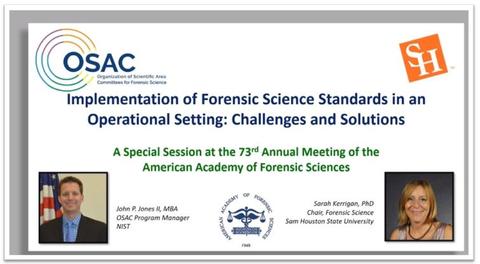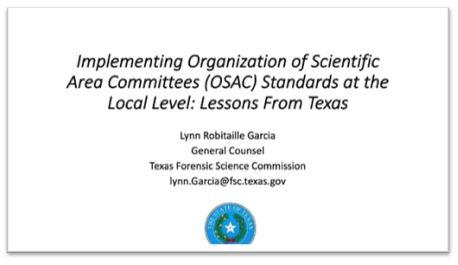OSAC at AAFS 2021

Almost 4,000 registrants from all over the world joined in for the 2021 AAFS Scientific Meeting held February 15-19. There were plenty of standards-related presentations and OSAC participation at the first AAFS virtual event.
Here are some highlights from the week:
Monday, February 15
Ten workshops took place on day-one with a record number of attendees. One of these workshops, What They Don’t Know Can Kill You, explored the role of forensic science standards in supporting evidence presented in criminal and civil court from the perspectives of the legal system and forensic science practitioners. Participating as a panelist from the practitioner view was Jason Wiersema, chair of OSAC’s Medicine SAC, who talked about the development of forensic science standards for disaster victim identification and their impact on forensic science. Similarly, Marc LeBeau, chair of the Chemistry: Seized Drugs and Toxicology SAC, shared his perspectives in the practitioner panel and discussed the development of standards for forensic toxicology and their impact on the field.
Tuesday, February 16

Day-two kicked off with a Case Break Session that provided an overview of the standards development process in the United States and internationally and OSAC’s role in the process. Karen Reczek, FSSB NIST Ex-Officio, talked about the various standards developing organizations (SDOs) working on forensic science standards and OSAC’s role to facilitate the development and implementation of these standards across the community. Additiionally, the ASB Secretariat described ASB’s standards development process in more detail as well as the standards that are currently in development and have been published through ASB.

Over 100 people joined in Tuesday morning for the Standards Consortium Session, The Implementation of Forensic Science Standards in an Operational Setting: Challenges and Solutions. JP Jones, OSAC Program Manager and Sarah Kerrigan, member of OSAC’s Forensic Toxicology Subcommittee, moderated and started this half-day session by providing an overview of OSAC, its membership structure, and the Registry. Then several OSAC members and affiliates shared some of the challenges and solutions associated with implementing forensic science standards in their laboratories. For example, Beth Ordeman, chair of the Human Forensic Biology Subcommittee, talked about ANSI/ASB Standard 020, Standard for Validation Studies of DNA Mixtures, and Development and Verification of a Laboratory’s Mixture Interpretation Protocol and ANSI/ASB Standard 040, Standard for Forensic DNA Interpretation and Comparison Protocols and the challenges and successes Pinellas County Forensic Laboratory had in implementing these standards. Other implementation case studies included ASTM E2329-17 Standard Practice for Identification of Seized Drugs (presented by OSAC affiliate Sandra Rodriguez-Cruz), ANSI/ASB Standard 017, Standard Practices for Measurement Traceability in Forensic Toxicology (presented by Dustin Yeatman, vice chair of the Forensic Toxicology Subcommittee), ASTM E2917-19a Standard Practice for Forensic Science Practitioner Training, Continuing Education, and Professional Development Programs (presented by OSAC affiliate Scott Oulton), and ANSI/ASB Best Practice Recommendation 009, Best Practice Recommendations for the Examination of Human Remains by Forensic Pathologist in the Disaster Victim Identification Context (presented by Elissia Conlon, member of the Medicolegal Death Investigation Subcommittee).
Also, on Tuesday members of OSAC’s Forensic Toxicology and Seized Drugs Subcommittees participated in the workshop, An Update on Analytical Approaches for Hemp/Marijuana Differentiation. As part of this workshop, Agnes Winokur, chair of OSAC’s Seized Drugs Subcommittee, shared the results from a survey the subcommittee conducted on hemp vs. marijuana differentiation.
Agnes also moderated the presentation, To See or Not to See: Unbiased Answers to Forensic Questions, that was part of Tuesday afternoon’s Interdisciplinary Symposium. This presentation offered various perspectives regarding the role of human bias in forensic science and the pursuit of truth and justice. Jose Almirall, OSAC affiliate and current chair of the FSSB Reporting & Testimony Task Group, discussed the role of standardization in reducing bias within the forensic chemistry disciplines.
Wednesday, February 17
The theme of this year’s AAFS Scientific Meeting and Wednesday’s Plenary Session was “One Academy Pursuing Justice through Truth in Evidence”. During the Plenary Session, Judge Chris Plourd, former FSSB member and current Legal Task Group and Forensic Toxicology Subcommittee member, emphasized the value of forensic science standards to the legal system. In his presentation, he noted that standards are a valuable resource for lawyers and judges to assess information about forensic evidence that may be at issue in a case and highlighted ASTM E2329, Standard Practice for the Identification of Seized Drugs as an example. He went on to explain that standards are utilized in court litigation quite a bit and provide transparency into the strengths and weaknesses (or limitations) of a methodology or discipline and may make that information more accessible for the bench and the bar.
Wednesday morning in the Criminalistics Session, Diana Wright, chair of OSAC’s Trace Materials Subcommittee, informed attendees on the new term the subcommittee has developed and is using in the interpretation of comparative spectral data. This term, “exclusionary difference” is being included in the current documents the subcommittee is drafting and will replace the term “meaningful difference” in previously issued documents as well. It is also expected to be implemented in other OSAC disciplines, where applicable.
Thursday, February 18

At the Jurisprudence Session Thursday morning, Lynn Garcia, member of OSAC’s Legal Task Group and the Seized Drugs Subcommittee, talked about the successes, challenges, and lessons the Texas Forensic Science Commission learned in implementing standards in a variety of laboratory settings. Lynn noted that in Texas, the Commission’s decisions with respect to OSAC implementation impact almost 100 laboratories, approximately half of which are physically located inside Texas. Along with Lynn, Mark Stolorow, OSAC affiliate, was present to answer attendee’s questions and share resources to help quality managers, senior management, and technical leaders with their implementation efforts.
Friday, February 19
The final day at AAFS brought presentations from the Digital/Multimedia Scientific Area Committee (DMSAC). In Part 1 of the DMSAC presentations, Lam Nguyen, chair of the Digital Evidence Subcommittee and David Marks, chair of the Speaker Recognition Subcommittee, informed attendees on the latest standards development activities happening in these two areas. Part 2 provided updates from OSAC’s Video/Imaging Technology & Analysis (VITAL) and Facial Identification Subcommittees, with presentations from Julie Carnes (VITAL Subcommittee chair) and Lora Sims (Facial Identification Subcommittee chair).
The standards presentations wrapped-up Friday afternoon with a talk from Libby Stern, member of the Trace Materials Subcommittee, who shared the goals, justification and purpose for the development of a standard for visual soil color determination as it applies to forensic soil examination.

